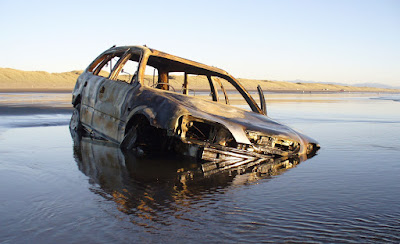I have been eerily quiet lately (on here anyway), and with good reason. After a very long time of toiling away in the lab, we finally managed to make something that has been eluding us for some time: a Bose-Einstein condensate!
A Bose-Einstein condensate (BEC) is a state of matter that occurs at extremely low temperatures. Other notable states of matter that you may be familiar with in your day to day life are gases, liquids, and solids. Usually the thing that determines what state something is in is temperature, with a fairly strict cutoff between states. The boiling point of water (100 degrees) is a good example. Pressure affects where those cutoffs are, so if you are high up on a mountain, the pressure is lower, and your water will boil at less than 100 degrees.
BECs are cold. Real cold. Ultracold (official term), in fact! They are so damn cold, you can't get anything colder. There is a hard limit in temperature called absolute zero. Nothing can be at absolute zero. It's impossible! However, you can get very very close, and at a billionth of a degree above absolute zero, BEC is a good example. Atoms in a BEC are all as cold as you can get. They are cold because they have very little energy, and they all have the same energy. They act in unison and behave more like waves than particles.
BECs don't occur naturally in the universe (that we know of) because space is much warmer, thanks to the cosmic microwave background. Instead, we have to play all kinds of tricks to get our atoms cold. An experimental setup like this is required for it:
I suppose you can see why it might take a long time...
A Bose-Einstein condensate (BEC) is a state of matter that occurs at extremely low temperatures. Other notable states of matter that you may be familiar with in your day to day life are gases, liquids, and solids. Usually the thing that determines what state something is in is temperature, with a fairly strict cutoff between states. The boiling point of water (100 degrees) is a good example. Pressure affects where those cutoffs are, so if you are high up on a mountain, the pressure is lower, and your water will boil at less than 100 degrees.
 |
| Not to any kind of scale and blatant disregard for using consistent units. |
BECs are cold. Real cold. Ultracold (official term), in fact! They are so damn cold, you can't get anything colder. There is a hard limit in temperature called absolute zero. Nothing can be at absolute zero. It's impossible! However, you can get very very close, and at a billionth of a degree above absolute zero, BEC is a good example. Atoms in a BEC are all as cold as you can get. They are cold because they have very little energy, and they all have the same energy. They act in unison and behave more like waves than particles.
BECs don't occur naturally in the universe (that we know of) because space is much warmer, thanks to the cosmic microwave background. Instead, we have to play all kinds of tricks to get our atoms cold. An experimental setup like this is required for it:
 |
| This is around half of the setup. |
I suppose you can see why it might take a long time...













